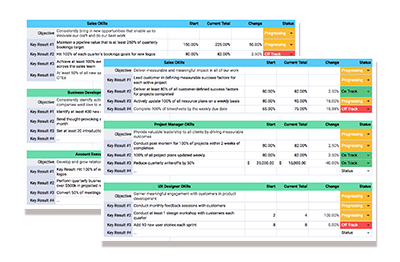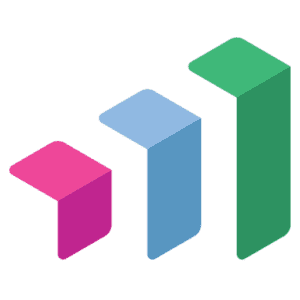The Power of OKRs for Professional Services Companies

Objectives and Key Results, what most people call “OKRs,” is more than a buzzy acronym used across the tech community.
This article explains the power of Objectives and Key Results (OKRs) for professional services companies. It provides an overview of OKRs and explains how they can be used to set ambitious goals and track performance. The article also outlines how companies can use OKRs to improve communication, alignment, and engagement among employees.
The key takeaways from the article are:
- OKRs are a framework that helps companies set ambitious goals and track performance.
- OKRs can be used to improve communication, alignment, and engagement among employees.
- Companies typically set OKRs using a similar structure to the org chart, with company-level, department-level, and individual employee OKRs.
- OKRs can be especially useful for digital services companies, as they allow for more qualitative objectives with quantitative and measurable key results.
- There are many examples of OKRs for different levels of a digital services company, which can help companies align to their goals and improve their workplace culture.
Table of Contents
- The power of OKRs
- Setting OKRs
- OKRs for digital services companies
- OKR examples for digital services companies
- Company-level OKRs
- Department-level OKRs
- FAQs
The power of OKRs
OKRs are a framework that helps companies set ambitious goals (objectives) and track how they’re performing against them (key results).
Former Intel CEO, Andy Grove, created the idea for OKRs by bringing it to Intel. In his book, High Output Management, Grove wrote that there are two essential questions companies need to answer to use a framework like OKRs:
- Where do I want to go? — This gives you the objective.
- How will I pace myself to see if I am getting there? — This gives you the key results.
Even though OKRs originated at Intel, they didn’t become popular in the tech community until people learned that Google used the framework to scale to the industry giant it is today. OKRs are now regarded as one of the best goal-setting frameworks, alongside other popular systems, like 4 Disciplines of Execution® , the Entrepreneurial Operating System® (EOS), and SMART Goals.
Setting OKRs
Typically, companies set OKRs using a similar structure to the org chart. There’s a high-level company OKR, supported by department OKRs, and individual employee OKRs. Here’s an example of a company-level OKR (see digital agency OKR examples further down in the article!):
- Objective: Be regarded as the industry leader in our market
- Key result #1: Be sought out for speaking or writing in three industry events or publications
- Key result #2: Secure the industry-leader spot on the G2 grid in our category
- Key result #3: Exceed a Net Promoter Score® of 80
OKRs for digital services companies
OKRs for marketing agencies have also gained popularity. The framework encourages leadership teams to write down and formalize what they’re trying to achieve and make it visible across the organization.
This exercise aligns employees on what the company is working toward, makes it easier for digital agencies to only say yes to the type of work that jives with where they’re trying to go, and improves communication through clarity and transparency. OKRs give structure to ambitious growth goals, giving digital agencies a path forward to achieve those goals.
Matthew Zehner , Founder & CEO of The Stable, a full-service digital agency specializing in eCommerce (and a Parallax customer), recently implemented OKRs. An unexpected benefit for his agency was that “the process of brainstorming OKRs across teams got employees out of their day-to-day work and thinking about where The Stable wants to go and how they fit into that. It inspired creative thinking and got people excited about the future.” – Matthew Zehner, Founder & CEO of The Stable
We’re a little biased since we use OKRs ourselves. But like Matthew, we think it’s a pretty cool framework. Here’s what we like best about OKRs for digital agencies:
- It allows agencies or software development firms to focus on Objectives that can be more qualitative in nature (e.g., “Win more work with the type of clients we like best.”), while still being quantitative and measurable with the supporting Key Results (e.g., “Win three new deals with companies disrupting the healthcare industry.”)
- Having different OKRs at each level of the company (high-level company objective, department objective, and individual employee objectives) helps employees see how they contribute to the firm’s success, increasing motivation and engagement.
- It makes the company’s direction and expectations of its employees crystal-clear, which companies often struggle with no matter how much they communicate.
OKRs, supported by the right tools to accurately measure how you’re performing (hint, hint 😉), can fuel growth for digital services companies.
OKR examples for digital services companies
While the OKR framework is simple, actually implementing and writing your objectives and key results can be tricky. You can find tons of advice about how to implement OKRs (including from Google, Hacker Noon, and Sachin Rekhi). When it comes to writing yours, don’t reinvent the wheel and waste your strategic energy. A lot of people (including us!) have already put in the work to craft OKR examples based on industry standards and best practices for what to measure.
To make this process simpler for you, we wrote OKR examples for all levels of a digital services company. These OKRs will help you align your company to its goals, create a workplace that wins the best clients, and attract and retain the best employees.
See a few of the OKR examples below or download our editable template for the complete list.

Company-level OKR
OKR example for professional service
- Objective: Significantly increase the enterprise value of the business
- Key Result: Increase annual revenue by 40%
- Key Result: Maintain at least an 80% repeat purchase rate
- Key Result: Maintain a net positive employee growth & self actualization rate
Department-level OKR
OKR example for marketing
- Objective: Build a brand that’s recognized as an industry leader in the craft
- Key Result: Secure five earned media placements per quarter
- Key Result: Publish or launch at least 5 forms of new content per month (e.g., thought leadership blog posts, white papers, events, or downloadable assets)
- Key Result: Increase the number of marketing qualified leads by15% month-over-month
- Key Result: Grow LinkedIn engagement by 200%
OKR example for sales
- Objective: Consistently bring in new opportunities that enable us to innovate our craft and do our best work
- Key Result: Maintain a pipeline value that is at least 250% of quarterly bookings target
- Key Result: Hit 100% of each quarter’s bookings goals for new logos
- Key Result: Achieve at least 100% average on-target earnings (OTE) across the sales team
- Key Result: At least 50% of all new sales reps meet or exceed first-year on-target earnings (OTE)
OKR example for project management
- Objective: Deliver measurable and meaningful impact in all of our work
- Key Result: Lead customer in defining measurable success factors for each active project
- Key Result: Deliver at least 80% of all customer-defined success factors for projects completed
- Key Result: Actively update 100% of all resource plans on a weekly basis
- Key Result: Complete 100% of timesheets by the weekly due date
OKR example for human resources
- Objective: Support an environment where every employee has a chance to realize their potential
- Key Result: Set objectives and key results that track to department goals for 100% active employees
- Key Result: Check in with 100% of active employees each month on their performance to OKR goals
- Key Result: Document career goals and development plan for 100% of active employees, including prioritized list of skills, capabilities, and experiences the employee aspires to develop
- Key Result: Develop recruiting pipeline for top five in-demand roles
OKR example for finance
- Objective: Profitably enable growth in revenue and continuous improvement in all aspects of the business
- Key Result: 100% of active projects in backlog mapped to revenue forecast and measured to benchmark
- Key Result: 100% of qualified deals in CRM mapped to revenue forecast and measured to benchmark
- Key Result: Maintain revenue, costs, and cash flow forecast with 100% coverage of pipeline and backlog
- Key Result: Maintain governance and data reporting for 100% of pipeline, backlog, and planned expenses
OKRs + Parallax = a winning combination
Goal-setting frameworks, including OKRs, are only as good as how well you can measure against them. If you don’t know what to measure — or how — the framework is useless. Once you know what to measure, your metrics are only useful if they’re based on accurate data. This is the downfall of most services companies when trying to implement OKRs. They think the framework sounds good in theory, but when it comes down to actually tracking the data needed to evaluate whether they’ve met their key results, they don’t know where to start.
It’s easy to see why this happens. Before Parallax, the tools for OKRs that digital agencies or software studios had available to them to measure and get visibility into data across the entire business (from the sales pipeline through project delivery) were old school and clunky. They didn’t work how these services companies needed them to.
Parallax was built to enable visibility, alignment, and accountability across the business. It supports the adoption of agency best practices and allows teams to track against agency benchmarks for metrics like utilization, project margin, and revenue. Like OKRs, Parallax fosters better and clearer communication between leadership and teams because it offers a level of transparency that’s otherwise difficult to achieve. Parallax is the measurement and resource planning tool that can sit on top of OKRs — helping everyone make smarter decisions that enable the company to grow.
FAQ
What does OKR stand for?
OKR stands for “Objectives and Key Results”. It’s a tracking and measurement framework used by individuals, teams, and companies to set goals and track against ambitious goals (objectives) and track against them over time (key results).
OKR vs. KPI. What’s the difference?
KPI stands for “Key Performance Indicator” and is another tracking method but is complimentary to the OKR framework. With OKRs, your objectives are clearly documented, as are the results you want to achieve for that objective. Its a qualitative and quantitate measure. KPIs on the other hand are simply a high-level quantitative result that you want to track.
What’s an effective OKR template?
Take a look at this great guide from Parallax to build an effective OKR template for individuals, teams, and companies.
What is the best OKR software?
There are tons of software and HR platforms out there to help you create and track OKRs. We’re fans of Lattice and use it at Parallax. But more important than the software is creating a culture that embraces the OKR framework! Services companies like digital agencies and software development studios trust Parallax to track and measure the operational health of the business. OKRs sit really nicely on top of a resource planning platform like Parallax 😉.
What are some good tools for OKR measuring?
Professional services companies like digital agencies and software development companies come to Parallax to function as a source of truth and reporting engine for their OKR framework. Parallax is purpose-built to help these types of companies optimize, track, and measure their operations for better performance.
